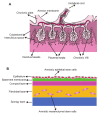Characteristics and Therapeutic Potential of Human Amnion-Derived Stem Cells
- PMID: 33478081
- PMCID: PMC7835733
- DOI: 10.3390/ijms22020970
Characteristics and Therapeutic Potential of Human Amnion-Derived Stem Cells
Abstract
Stem cells including embryonic stem cells (ESCs), induced pluripotent stem cells (iPSCs) and adult stem cells (ASCs) are able to repair/replace damaged or degenerative tissues and improve functional recovery in experimental model and clinical trials. However, there are still many limitations and unresolved problems regarding stem cell therapy in terms of ethical barriers, immune rejection, tumorigenicity, and cell sources. By reviewing recent literatures and our related works, human amnion-derived stem cells (hADSCs) including human amniotic mesenchymal stem cells (hAMSCs) and human amniotic epithelial stem cells (hAESCs) have shown considerable advantages over other stem cells. In this review, we first described the biological characteristics and advantages of hADSCs, especially for their high pluripotency and immunomodulatory effects. Then, we summarized the therapeutic applications and recent progresses of hADSCs in treating various diseases for preclinical research and clinical trials. In addition, the possible mechanisms and the challenges of hADSCs applications have been also discussed. Finally, we highlighted the properties of hADSCs as a promising source of stem cells for cell therapy and regenerative medicine and pointed out the perspectives for the directions of hADSCs applications clinically.
Keywords: amniotic membrane; human amniotic epithelial stem cells; human amniotic mesenchymal stem cells; human amniotic stem cells; regenerative medicine.
Conflict of interest statement
The authors declare no conflict of interest.
Figures




References
Publication types
MeSH terms
Grants and funding
LinkOut - more resources
Full Text Sources
Other Literature Sources

